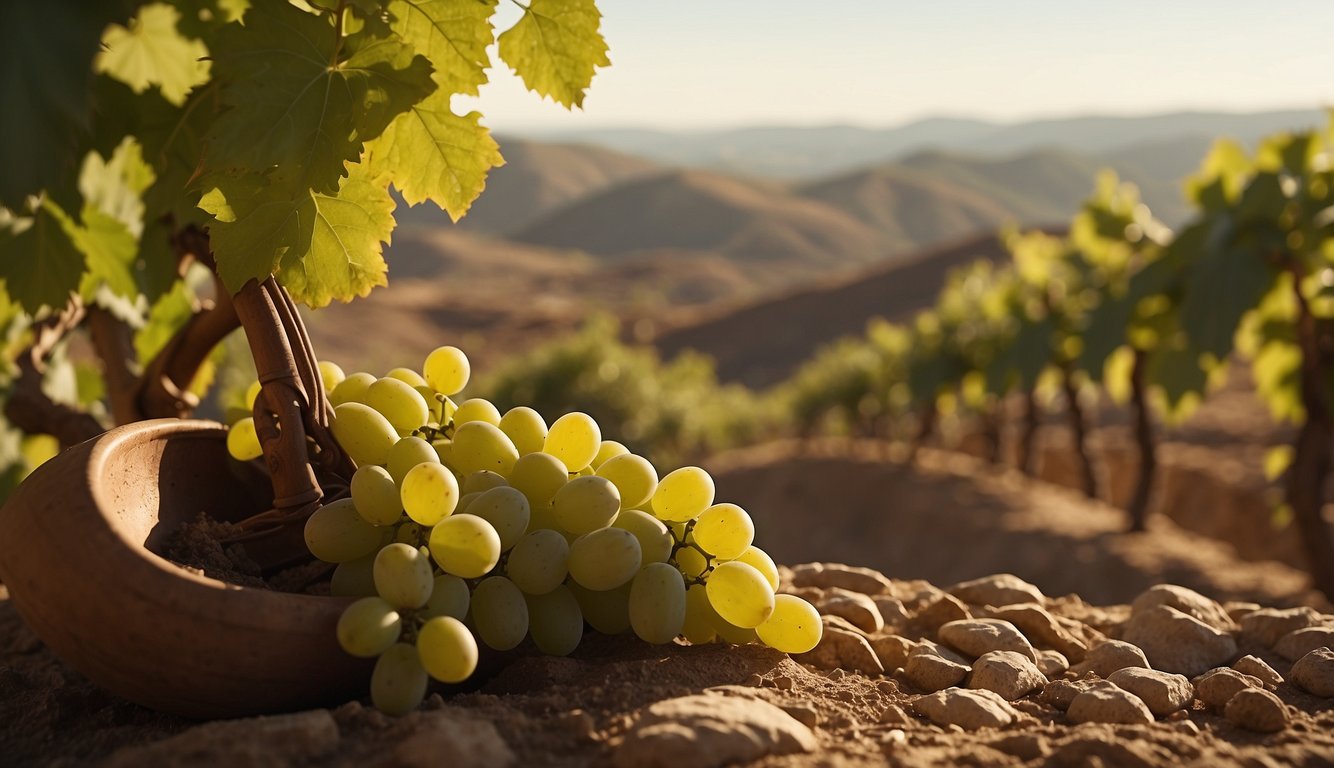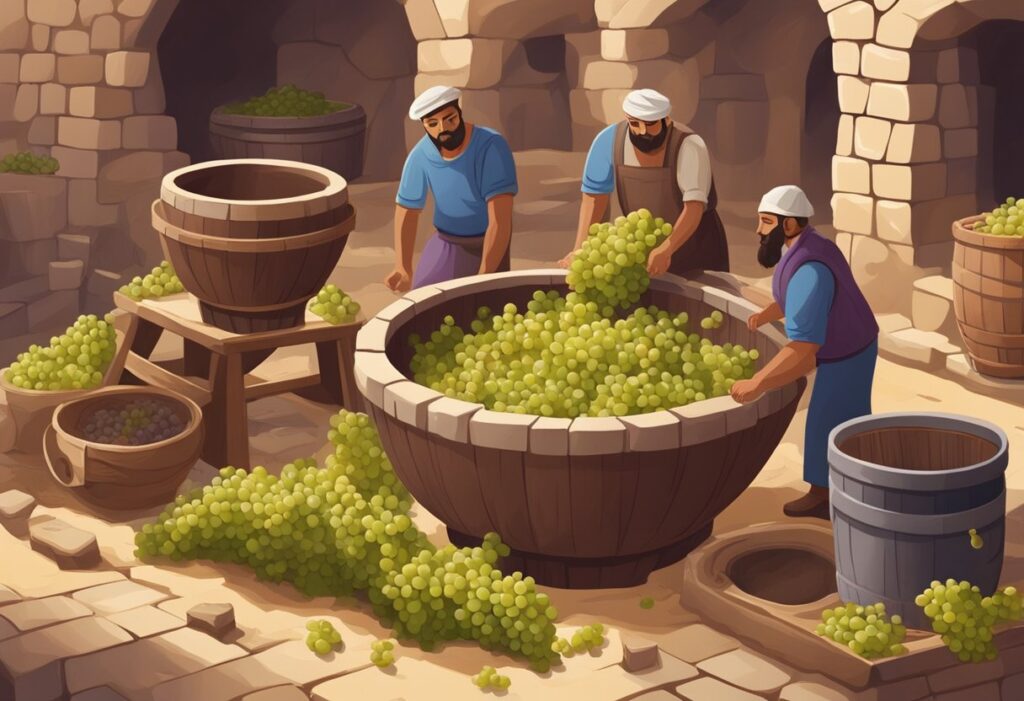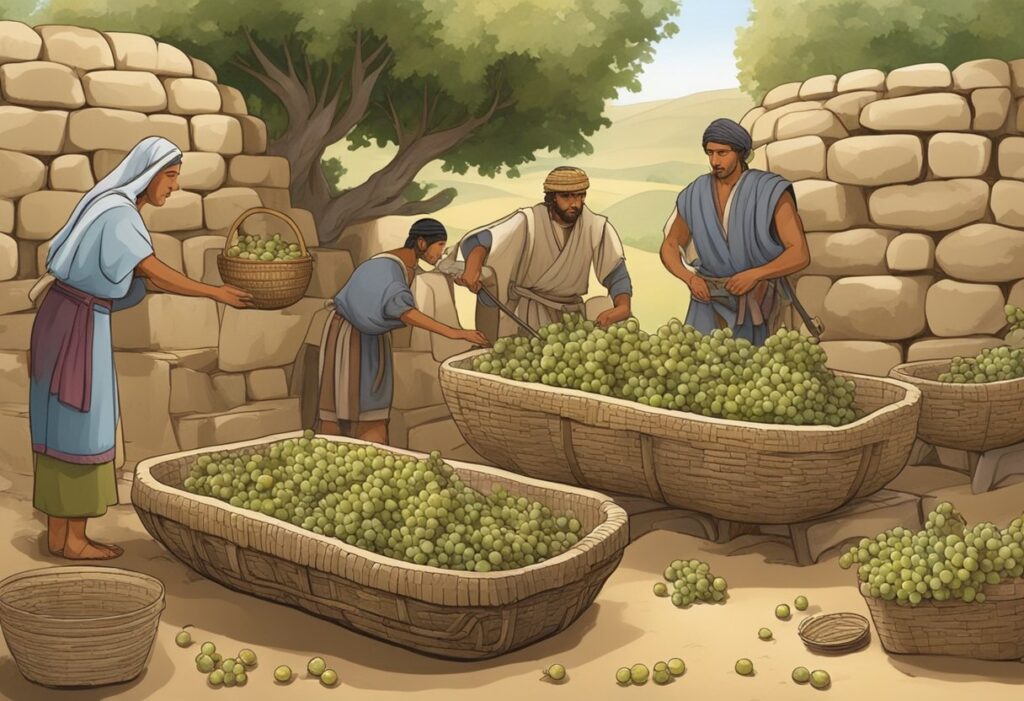Imagine sipping a glass of wine that holds centuries of history in every drop. Winemaking is an ancient craft that traces its roots back to the dawn of civilization in Mesopotamia, where grape domestication and wine production first emerged around 6000 BC. This early innovation not only highlighted the technical skill of these early peoples but also underscored wine’s cultural significance.

Winemaking’s history is deeply intertwined with Mesopotamian society, where it played essential roles in religious ceremonies and daily life. Archaeological findings, such as those at the site of Hajji Firuz Tepe, reveal wine jars containing residues of tartaric acid, pointing to ancient methods of production. These early winemakers set the foundation for the wine cultures that would later flourish in regions around the world.
You can dive deeper into this fascinating history by exploring how winemaking influenced Mesopotamian culture and beyond. Unveil the secrets of ancient wine making and understand the monumental journey from those early vineyards to the sophisticated winemaking techniques of today.
The Cradle of Wine: Mesopotamia and the Zagros Mountains
Mesopotamia and the Zagros Mountains are key areas in the history of winemaking. This region provided the ideal conditions for early grape cultivation, giving rise to ancient viniculture practices.
Unearthing the Past: Archaeological Discoveries
Archaeologists have made significant finds in the Zagros Mountains, unveiling the depth of ancient winemaking. One important site is Hajji Firuz Tepe. Excavators at this location discovered pottery vessels containing residues of tartaric acid, a hallmark of grape fermentation that dates back to around 6000 BCE.
Another notable find includes Elamite cylinder seals depicting winemaking scenes. These artifacts, along with pottery shards found in other parts of Mesopotamia, paint a vivid picture of ancient wine culture. The artifacts not only show the existence of winemaking but also hint at its cultural importance in social rituals and daily life. Mesopotamia’s location, between the Tigris and Euphrates, also facilitated the distribution of wine throughout the region.
Ancient Grapes: The Wild Ancestors of Viticulture
The wild grapes of the Zagros Mountains are believed to be the ancestors of domesticated grapevines, specifically Vitis vinifera L. Early humans likely found these grapes growing naturally and began the process of domestication. Evidence points to the cultivation of these grapes for winemaking as early as the mid-3rd millennium B.C.
Domesticated grapes offered more desirable traits for winemaking, such as improved taste and yield. The transition from wild to cultivated grapes marked a major advancement in viticulture. This process allowed Mesopotamians to produce wine more consistently and in greater quantities. By domesticating grapes, ancient Mesopotamians laid the foundation for future grape cultivation and winemaking practices that evolved over millennia.
Domestication and Cultivation: From Wild Grapes to Gardened Vineyards
In this section, you’ll discover how wild grapes were transformed through domestication and how ancient techniques paved the way for vibrant vineyards and the birth of winemaking.
The Birth of Grape Cultivation
Domestication began with humans selecting the best wild grapes (Vitis vinifera L.) for their desirable traits. This process started in the Near East, where early farmers collected the grapes to grow closer to home. They planted and nurtured these vines, leading to the first grape cultivation efforts.
Ancient farmers noticed that some grapes were sweeter, larger, or had better flavors. So, they selectively bred these vines, improving their quality over generations. This was a crucial step that laid the foundation for grape cultivation as we know it today.
Early viticulture practices involved simple techniques to protect the vines and help them grow. They used basic tools and irrigation methods to ensure the plants thrived. These efforts led to more abundant and consistent grape production, setting the stage for further advancements in winemaking.
Crossing the Threshold: From Grapes to Wine
The transformation from grape cultivation to winemaking marked a significant turning point. People discovered that fermenting grapes produced a delightful beverage. This ancient wine became a valuable part of their daily lives and cultures.
Different regions developed their unique methods for making wine, leading to a diversity of flavors and styles. In Western Asia and the Caucasus, there were dual domestications of Vitis vinifera. Each area brought its twist to viticulture, enhancing the wine’s characteristics.
As cultivation and winemaking techniques evolved, so did the quality of the wine. The ancient wine became more refined, reflecting the growers’ expertise and the specific terroir of the vineyards. These advancements brought about the richly varied wines enjoyed throughout history and even today.
Fermentation and Flavor: The Science Behind Ancient Winemaking

Fermentation in ancient winemaking was a complex process involving yeast, honey, and sometimes herbs. These ingredients added unique flavors, transforming simple grape juice into a beloved beverage.
The Chemistry of Fermentation
Fermentation starts when yeast converts the sugars in grape juice into alcohol and carbon dioxide. The ancient Sumerians and Babylonians were among the first to use this process. They likely noticed that natural yeast on grape skins caused spontaneous fermentation in clay vessels called amphorae.
A key component in this process is tartaric acid, which maintains the wine’s stability and flavor. Yeast like Saccharomyces cerevisiae is essential as it ferments the grape sugars into ethanol, creating wine. This discovery has roots in significant early research, such as Eduard Buchner’s demonstration in 1897 that cell-free extracts could also ferment sugars.
Adding Complexity: Honey, Herbs, and Water
Ancient winemakers added honey, herbs, and sometimes even water to enhance the wine’s flavor. Honey introduced additional sugars, which yeast would ferment, affecting the sweetness and alcohol content. Herbs like thyme or rosemary infused aromatic flavors into the wine.
Egyptian records show that pharaohs often enjoyed flavored wines with spices and herbs, adding layers of complexity. By controlling the ingredients, ancient winemakers could create a variety of unique wines. This practice was common in Mesopotamia, where winemakers used local ingredients to customize the flavor, making winemaking as much an art as a science.
These techniques showcase the creativity and scientific insights of ancient winemakers. They laid the groundwork for modern enology, demonstrating how simple ingredients like honey and herbs can significantly impact the final product.
Trade and Expansion: How Wine Shaped the Ancient World

Wine’s journey from a local drink to a traded luxury item influenced many aspects of ancient society, including commerce, culture, and social practices.
From Local Staple to Global Luxury
Wine started as a local staple in many ancient civilizations, especially in Mesopotamia. The hot and dry climate made grapevines difficult to grow, yet people still managed to produce wine. As wine production techniques improved, it became more than just a drink; it turned into a luxury symbol.
Social gatherings like Greek symposia and Roman banquets featured wine as a central element. These events showcased wine’s importance and solidified its status as a premium product. Over time, wine moved beyond local markets and began to reach international audiences, turning into a highly desired luxury item across various regions.
The Ancient Wine Trade Networks
The ancient wine trade grew significantly, connecting various cultures. Traders transported wine via land and sea routes, turning it into a staple in the ancient Mediterranean. The Greeks and Romans played pivotal roles in establishing these networks. The Greeks institutionalized wine-drinking in their famous symposia.
Greek colonies across the Mediterranean, such as those in Italy and France, helped spread winemaking knowledge. The Roman Empire expanded these trade routes further, making wine accessible throughout Europe and parts of Asia and Africa.
Archaeological finds, like ancient wine presses in Israel and wine jugs in Georgia, reveal the extensive reach of these networks. These artifacts show the technical advancements and widespread enjoyment of wine, emphasizing its role in ancient society.
Cultural Significance: Wine in Religion, Medicine, and Daily Life

Wine has played a critical role in shaping ancient Mesopotamian culture, from religious rituals to daily social interactions. These practices influenced the societies of the Sumerians and Babylonians, embedding wine deeply into the fabric of human culture.
Divine Gift: Wine in Religious Ceremonies
In ancient Mesopotamia, wine was seen as a divine gift from the gods. It was central to many religious ceremonies, symbolizing sacrifice, sanctity, and celebration. The Sumerians and Babylonians would offer wine to their deities, believing it connected them to the divine realm.
You can see this belief mirrored in other ancient cultures. For example, the Greeks dedicated wine to Dionysus, the god of wine and festivities, highlighting the sacredness of wine. Mesopotamians utilized elaborate rituals where wine played a critical role in temple ceremonies and festivals, demonstrating their deep spiritual connection to this ancient beverage.
Beyond the Sacred: Wine’s Role in Social Structures
Wine extended beyond religious rituals into the everyday lives of the Sumerians and Babylonians. It was a key component of social gatherings, including feasts and banquets. These gatherings helped to reinforce social bonds and hierarchy, as wine was often shared among participants.
Moreover, wine was not just for the elite. It became available to the broader populace, providing a social lubricant that facilitated communication and relaxed social barriers. This democratization of wine use reflects its cultural significance and the role it played in uniting various social classes within ancient Mesopotamia.
Additionally, wine held medicinal value. It was used for its healing properties and often prescribed for various ailments, reflecting the multifaceted importance of wine in ancient Mesopotamian society. Through these varied uses, wine maintained a strong presence in both the sacred and mundane aspects of daily life.

